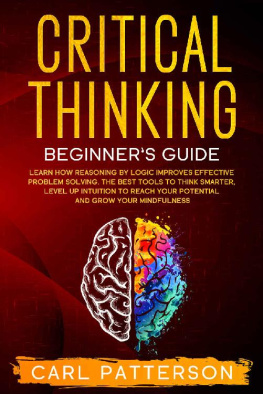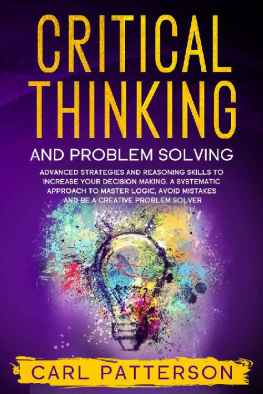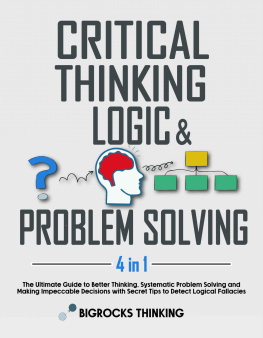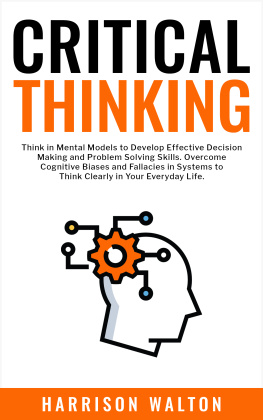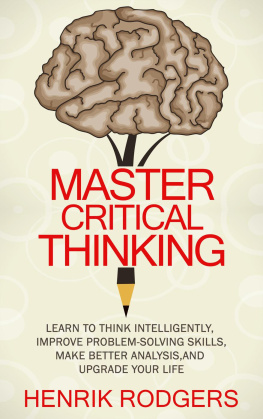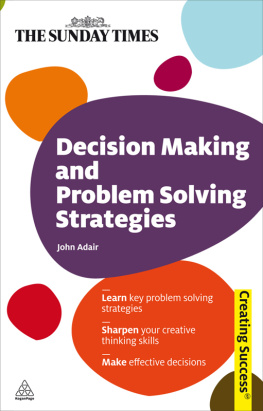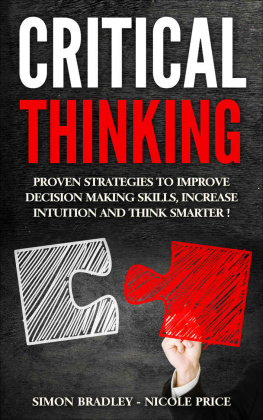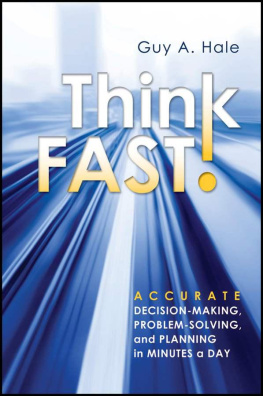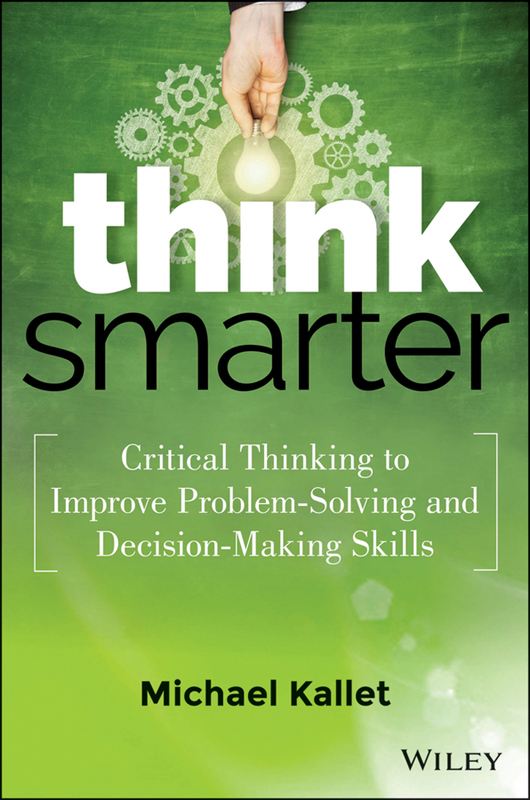
Contents
List of Illustrations
Pages
Guide
think smarter
Critical Thinking to Improve Problem-Solving and Decision-Making Skills
Michael Kallet
Cover image: tumpikuja/iStockphoto
Cover design: Michael J. Freeland
Copyright 2014 by Mike Kallet. All rights reserved.
Published by John Wiley & Sons, Inc., Hoboken, New Jersey.
Published simultaneously in Canada.
No part of this publication may be reproduced, stored in a retrieval system, or transmitted in any form or by any means, electronic, mechanical, photocopying, recording, scanning, or otherwise, except as permitted under Section 107 or 108 of the 1976 United States Copyright Act, without either the prior written permission of the Publisher, or authorization through payment of the appropriate per-copy fee to the Copyright Clearance Center, 222 Rosewood Drive, Danvers, MA 01923, (978) 750-8400, fax (978) 646-8600, or on the web at www.copyright.com. Requests to the Publisher for permission should be addressed to the Permissions Department, John Wiley & Sons, Inc., 111 River Street, Hoboken, NJ 07030, (201) 748-6011, fax (201) 748-6008, or online at www.wiley.com/go/permissions.
Limit of Liability/Disclaimer of Warranty: While the publisher and author have used their best efforts in preparing this book, they make no representations or warranties with respect to the accuracy or completeness of the contents of this book and specifically disclaim any implied warranties of merchantability or fitness for a particular purpose. No warranty may be created or extended by sales representatives or written sales materials. The advice and strategies contained herein may not be suitable for your situation. You should consult with a professional where appropriate. Neither the publisher nor the author shall be liable for damages arising herefrom.
For general information about our other products and services, please contact our Customer Care Department within the United States at (800) 762-2974, outside the United States at (317) 572-3993 or fax (317) 572-4002.
Wiley publishes in a variety of print and electronic formats and by print-on-demand. Some material included with standard print versions of this book may not be included in e-books or in print-on-demand. If this book refers to media such as a CD or DVD that is not included in the version you purchased, you may download this material at http://booksupport.wiley.com. For more information about Wiley products, visit www.wiley.com.
Library of Congress Cataloging-in-Publication Data:
Kallet, Mike, 1953
Think smarter : critical thinking to improve problem-solving and decision-making skills / Mike Kallet.
p. cm.
ISBN 978-1-118-72983-0 (hardback); ISBN 978-1-118-86435-7 (ebk);
ISBN 978-1-118-87125-6 (ebk)
1. Problem solving. 2. Decision making. 3. Critical thinking. I. Title.
HD30.29.K35 2014
658.4'03dc23
2013044790
To my dad, Sidney Kallet, who thought, and thought well.
PREFACE
Thinking is the process that every human being uses to solve problems, make decisions, generate new ideas, and be creative. The goal of Think Smarter is to answer the question How exactly do we get better at problem solving, decision making, and creativity? Actually, the question is If thinking is what we use to solve problems, then how do we improve our thinking with respect to solving problems? The inspiration to write this book came from years of helping others answer that question.
People often ask me if its truly possible to teach people to be smarter. The answer depends on how you define smarter. If it means increasing intelligence quotient (IQ) points, then the answer is probably not. But if becoming smarter means applying your IQ in a way that produces more successful problem solving and better decisions, then the answer is absolutely yes.
Critical thinking isnt about making people smarter; its about using a set of tools and techniques to think in a more effective way. Critical thinking wont increase IQ points, but it will help people apply whatever level of intelligence they have in a way that produces higher-quality solutions. It raises the bar for everyone and improves both individuals and organizations overall performance.
Why I Wrote This Book
I had enjoyed a successful career in software development from the beginning of the personal computer (PC) revolution and then worked as an operations and technology executive in the rocketing Internet space. Then, in 2003, I found myself in yet another fast-changing business. I was a senior executive in a telecommunications company, sitting in a boardroom with 20 other executives during the first of a series of strategy sessions to create a five-year plan. A question was raised: What did we want to be five years from then? After a few jokes about running a beach and golf resort in Hawaii, the conversations began to coalesce around becoming a billion-dollar company. A very interesting line graph was drawn. Our revenue had been on the decline; the graph was decreasing through the then-current $400 million per year revenue but then made an abrupt upward slope to $1 billion. There were no discussions about being the best telecommunications company, developing unique solutions, having the fastest network, being the best in customer satisfaction, or being a profitable, great place to work. Rather, we determined that if we were to be a billion-dollar company, we would need to sell so much of this, sell so much of that, and sell it in this number of cities. There werent any conversations about what we would have to do differently to change from a decreasing revenue stream to a very significant and aggressively growing one.
That was the moment when I sat back in my chair and asked myself a question: I wonder if anyone in this room, including myself, is actually doing any real thinking? Soon after that meeting, I started to think about thinking.
After doing a bit of research, I determined that there always seemed to be two ingredients present for successful businesses. The first was persistence. Companies that consistently do well embrace a statement I like: Theres always a way. The second ingredient was quality thinking: real, hard, roll-up-the-sleeves, not-taking-anything-for-granted thinking. Ive noticed throughout my own career that when people really think about something and ask questionseven when they know the answerthey tend to come up with new solutions to a problem, arrive at a new decision, or realize an innovation. It doesnt happen every time, but it happens often enough.
Although persistence is an important ingredient in success, I decided to focus my work primarily on thinking. In the autumn of 2004, I started a company I named HeadScratchers, LLC. The goal was to help peoplenot just executives, but individuals, supervisors, and managers as wellbecome better headscratchers, that is, better problem solvers, decision makers, and innovators. I wanted HeadScratchers to take a different approach from the traditional academic focus of logic, inference, and Boolean algebra many other thinking consultants offered. This was about business problem solving, in the real world, for people who needed a few good tools in their toolbox. Our target audience was business people who dont have the time or interest to understand the science of left brain/right brain, neurochemical stuff. The goal was to provide, train, and coach business people with skills they could use, on their own or with others, to be more thoughtful when tackling problems, making decisions, or innovating. This meant training with an interactive workshop, so HeadScratchers became a training, coaching, and interactive workshop company, focused 100 percent on the business use for critical thinking. In 2006, we rolled out our first workshop, Critical Thinking for Problem Solving and Decision Making.
Next page

